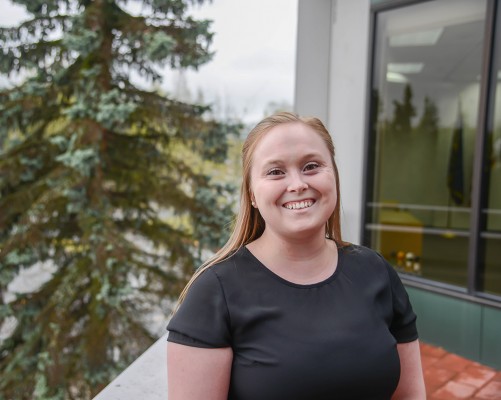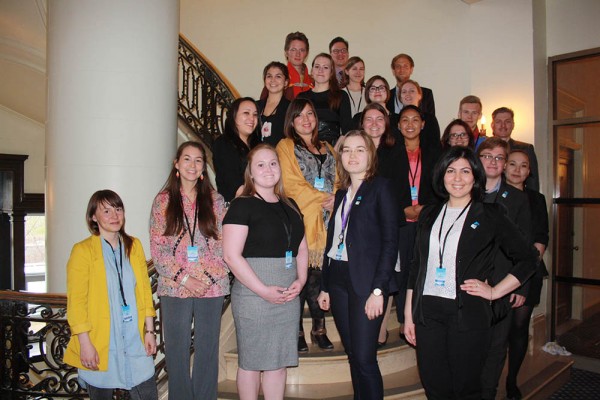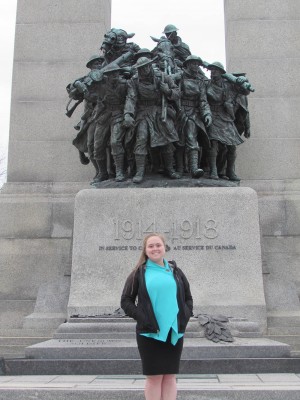Exploring ways to weave Arctic indigenous culture with commerce
by Tracy Kalytiak |

Chantae Kochuten, who graduated from UAA earlier this month, took part in the Future Arctic Leaders Workshop in Ottawa, Canada, in April. (Photo by Theodore Kincaid/University of Alaska Anchorage)
Though her parents lived in the Aleutian communities of False Pass, Dutch Harbor and King Cove, Chantae Kochuten and her three sisters practically grew up on drift boats, plying the so-called "Area M" fishery for salmon in the Bering Sea and Gulf of Alaska.
Commerce and culture intertwined as Kochuten grew up.
"My family subsistence hunted for caribou and harbor seal and fished for halibut," said the UAA graduate, who received a UAA Bachelor of Business Administration degree in management in May. "We picked berries seasonally to make jams and jellies and gathered and ate chitons-badarkis-and sea urchins off the beaches and reefs. When the seagulls were nesting, we would take a skiff out to the small islands surrounding the island to harvest seagull eggs to eat and bake with."
Supporting Alaska Native communities
Her interest in business and leadership brought Kochuten to UAA's Leadership Fellows Program and a job with the Aleutian Pribilof Island Community Development Corp.

Chantae Kochuten, third from left, recently took part in the Future Arctic Leaders Workshop in Ottawa, Canada.
The Aleut International Association, a nonprofit, is a permanent participant in the Arctic Council, which addresses environmental and cultural issues faced by the world's eight northernmost countries and the indigenous people who live in them. Members are the United States, Canada, Russia, Iceland, Denmark, Norway, Sweden and Finland; the six international indigenous organizations affiliated with the Arctic Council are AIA, Arctic Athabaskan Council, Gwich'in Council International, Inuit Circumpolar Council, Russian Association of Indigenous Peoples of the North and the Saami Council. The U.S. began its second two-year chairmanship of the organization last month, succeeding Canada.
AIA wanted to send a representative to the Arctic Council's Future Arctic Leaders Workshop, in Ottawa, Canada. Kochuten's older sister, Nadine, told her in March about the opportunity; Nadine had previously attended an AIA-sponsored event, participating in a United Nations indigenous peoples forum in Brussels.
"My sister was too old to go," Kochuten said. "To participate, you had to be between the ages of 21-30, with a valid passport and available to travel."
Kochuten submitted a 500-word essay as part of her application.
The main goal she and her employer have, Kochuten said in the essay, is to support people in these coastal communities-enhancing their long-term social and economic viability while at the same time respecting their traditions and cultures.
"Each year, we [APICDA staff] meet with the governing entities from our region to address the needs of each community, discuss areas for improvement and present opportunities as far as development goes," Kochuten wrote. "I believe this concept of collaborative development and respect for Arctic Native people is what the Arctic Council promotes through their theme, 'Development for the People of the North, and Development by the People of the North.'"
Kochuten said the Arctic Council should serve as a platform where stakeholders can talk with fully informed participants currently living in the Arctic about the interests, opportunities and barriers to future development.
"Things such as economic impact statements that researchers use for development projects do not always take into account the social needs of the people in these areas," she wrote. "People are the most important resource in the Arctic and any future development needs to recognize this. All future development in the Arctic should have benefit-sharing policies with the Native people in the areas. Things like this ensure that the native Arctic people are not displaced economically or socially."
The essay helped win Kochuten a spot on a plane to Ottawa the following month.
Protecting the Arctic
During her three-day trip to Ottawa, Kochuten took in a webcast of the ninth Arctic Council Ministerial meeting, at which the council's chairmanship passed from Canada to the United States, and met with 20 other young people to discuss unique opportunities and challenges facing the Arctic region.

Chantae Kochuten visits the National War Memorial and Tomb of the Unknown Soldier in Ottawa, Canada, during a brief break from proceedings in the Future Arctic Leaders Workshop she attended in late April.
Climate change, for example, is an environmental menace. But, it also opens possibilities, Kochuten said.
"More countries, more people are becoming interested in the Arctic," she said. "They're looking north for opportunities. As the Arctic, through climate change, becomes more accessible, people are becoming more interested in it because you can now do things there. It's a growing interest recognized by these eight member states 18 years ago. What they want to do is ultimately protect it, to sustain it and not have it exploited."
'We just want to be involved'
Kochuten says the people who took part in the workshop aren't seeking a voting spot on the Council-yet.
"But letting us see what goes on, letting us understand and see firsthand that unfiltered discussion between the ministers, it's really important to us to be able to see that so when it comes time for us to step up, we know how to do it," she said. "It's kind of passing on that knowledge. We just want to be involved, have a voice, just to participate and take interest in and voice concerns we have from a student's or a young leader's point of view."
Kochuten wants to continue participating in workshops like the one in Ottawa. "My point is just to ask if I can participate, to keep track of what the Arctic Council is doing," she said. "When it comes to things I'm interested in, leadership and self governance, to ask if I can participate in those things."
Her days in Ottawa flew by, Kochuten said. She flew 6,519 miles from Anchorage to Ottawa and flew those 6,519 miles back to Alaska that Saturday.
She left behind one item of unfinished business in Canada's capital city.
"I got in on the 22nd, the 23rd was the workshop, the 24th was the ministerial meeting and then I left the morning of the 25th," she said. "I'd planned on doing touristy stuff on the morning of the 24th. One of the main things I wanted to see was the Library of Parliament, which is one of the top 20 libraries to visit in the world. It's beautiful. But-Canadian Parliament is closed on Fridays. So I didn't get to go. Now I really want to go back, because I feel like I need to see it."
Kochuten brought back the following information about the U.S. projects the Arctic Council lauded in its compendium of best practices in promoting traditional ways of life of Arctic indigenous peoples:
• Each year, the Urban Unangax culture camp attracts nearly 200 participants who join together at the Aleutian Pribilof Islands Association's Anchorage headquarters to explore and revitalize cultural traditions like dancing, singing and preparation of halibut fish pies, seal-meat patties and other traditional foods. Camp participants also create Aleut art. The camp is open to all, but its primary audience is youth of Unangax (Aleut) descent who are affiliated with one of the Aleutian Pribilof Islands region's 13 tribal communities, as well as shareholders or shareholder descendants of the Aleut Corp. APIA organized the camp in 2008 in response to requests from Aleuts living in Anchorage who had moved to the city due to a decline in the fishing industry and an unstable economy in their home region.
• The Aleut International Association coordinated a project that created an online searchable record of existing information on plants used by the Aleut. The document lists the common, scientific and Aleut names of plants, along with information on their traditional uses. "The project is a best practice because it ...identifies the knowledge gaps that can be addressed through further research," the compendium stated.
• Local communities and elders published a book compiling stories, experiences, recipes and wisdom related to traditional foods shared by elders, food preparers and hunters from the Aleutian Pribilof Islands region. The project addressed a problem: As elders pass away, fewer people left behind know how to properly collect and prepare traditional foods. Financial support for the project-done with the help of author Suanne Unger-came from the APIA and the U.S. Centers for Disease Control and Prevention.
• Residents of Gambell and Savoonga helped prepare a catalog based on photos taken in Aleut communities during the 1920s-1930s; the Smithsonian National Museum of the American Indian acquired the photos in 2002. "The project is a best practice because it demonstrates that old photographs, when combined with information provided by elders, can raise awareness and foster respect of traditions and past ways of life," the compendium stated. "This process helped reconnect people to the history of their communities. The catalog documents what communities looked like, and how people lived and organized their lives." Six hundred copies of the catalog were given to village councils in the two communities, which then distributed a copy to each family.
• "Yuungnaqpiallerput/The Way We Genuinely Live" is a project involving a website, catalog, bilingual publication and traveling ethnographic exhibit documenting 19th-century Yup'ik technologies and practices, their contemporary applications and the scientific processes underlying them. The exhibit's design focused on the four seasons and included 250 Yup'ik technical masterworks ranging from a needle made from the wing bone of a crane to a bearskin boat. The exhibit, supported by activities and films, toured and gave patrons direct encounters with Yup'ik culture and the role science plays in everyday Yup'ik life. The project was a collaboration between the Anchorage Museum of History and the Calista Elders Council, with support from the National Science Foundation.
• A multidisciplinary and cross-cultural project examines the relationship of native peoples to Yakutat Bay, through a combination of scientific research, filmmaking and education. It integrates indigenous knowledge, oral tradition, linguistics, archaeology, glacial geography and seal biology to explore the 1,000-year-old relationship between people, seals and the evolving landscape.
Written by Tracy Kalytiak, UAA Office of University Advancement
 "Exploring ways to weave Arctic indigenous culture with commerce" is licensed under a Creative Commons Attribution-NonCommercial 4.0 International License.
"Exploring ways to weave Arctic indigenous culture with commerce" is licensed under a Creative Commons Attribution-NonCommercial 4.0 International License.














